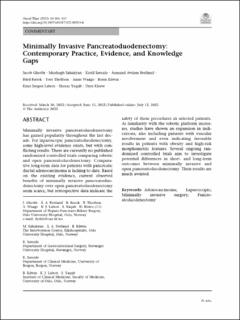| dc.contributor.author | Ghotbi, Jacob | |
| dc.contributor.author | Sahakyan, Mushegh | |
| dc.contributor.author | Søreide, Kjetil | |
| dc.contributor.author | Fretland, Åsmund Avdem | |
| dc.contributor.author | Røsok, Bård Ingvald | |
| dc.contributor.author | Tholfsen, Tore | |
| dc.contributor.author | Waage, Anne | |
| dc.contributor.author | Edwin, Bjørn von Gohren | |
| dc.contributor.author | Labori, Knut Jørgen | |
| dc.contributor.author | Yakub, Sheraz | |
| dc.contributor.author | Kleive, Dyre | |
| dc.date.accessioned | 2023-04-24T09:06:28Z | |
| dc.date.available | 2023-04-24T09:06:28Z | |
| dc.date.created | 2023-03-28T14:16:11Z | |
| dc.date.issued | 2022 | |
| dc.identifier.issn | 2366-1070 | |
| dc.identifier.uri | https://hdl.handle.net/11250/3064431 | |
| dc.description.abstract | Minimally invasive pancreatoduodenectomy has gained popularity throughout the last decade. For laparoscopic pancreatoduodenectomy, some high-level evidence exists, but with conflicting results. There are currently no published randomized controlled trials comparing robotic and open pancreatoduodenectomy. Comparative long-term data for patients with pancreatic ductal adenocarcinoma is lacking to date. Based on the existing evidence, current observed benefits of minimally invasive pancreatoduodenectomy over open pancreatoduodenectomy seem scarce, but retrospective data indicate the safety of these procedures in selected patients. As familiarity with the robotic platform increases, studies have shown an expansion in indications, also including patients with vascular involvement and even indicating favorable results in patients with obesity and high-risk morphometric features. Several ongoing randomized controlled trials aim to investigate potential differences in short- and long-term outcomes between minimally invasive and open pancreatoduodenectomy. Their results are much awaited. | en_US |
| dc.language.iso | eng | en_US |
| dc.publisher | Springer | en_US |
| dc.rights | Navngivelse-Ikkekommersiell 4.0 Internasjonal | * |
| dc.rights.uri | http://creativecommons.org/licenses/by-nc/4.0/deed.no | * |
| dc.title | Minimally Invasive Pancreatoduodenectomy: Contemporary Practice, Evidence, and Knowledge Gaps | en_US |
| dc.type | Journal article | en_US |
| dc.type | Peer reviewed | en_US |
| dc.description.version | publishedVersion | en_US |
| dc.rights.holder | Copyright 2022 The Author(s) | en_US |
| cristin.ispublished | true | |
| cristin.fulltext | original | |
| cristin.qualitycode | 1 | |
| dc.identifier.doi | 10.1007/s40487-022-00203-6 | |
| dc.identifier.cristin | 2137626 | |
| dc.source.journal | Oncology and Therapy | en_US |
| dc.source.pagenumber | 301-315 | en_US |
| dc.identifier.citation | Oncology and Therapy. 2022, 10, 301-315. | en_US |
| dc.source.volume | 10 | en_US |
| dc.source.issue | 2 | en_US |

